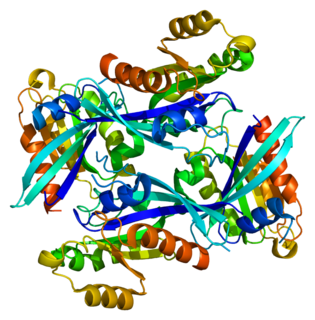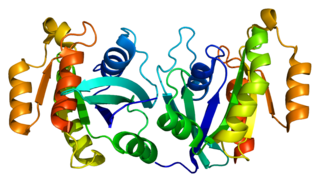Golgin subfamily A member 2 is a protein that in humans is encoded by the GOLGA2 gene. [5]
Golgin subfamily A member 2 is a protein that in humans is encoded by the GOLGA2 gene. [5]
The Golgi apparatus, which participates in glycosylation and transport of proteins and lipids in the secretory pathway, consists of a series of stacked cisternae (flattened membrane sacs). Interactions between the Golgi and microtubules are thought to be important for the reorganization of the Golgi after it fragments during mitosis. The golgins are a family of proteins, of which the protein encoded by this gene is a member, that are localized to the Golgi. This encoded protein has been postulated to play roles in the stacking of Golgi cisternae and in vesicular transport. Several alternatively spliced transcript variants of this gene have been described, but the full-length nature of these variants has not been determined. [6]
A patient with a neuromuscular disorder has been identified that is homozygous for a deletion mutation in this gene, and morpholino knockdown in zebrafish has shown similar phenotypes. [7]
GOLGA2 has been shown to interact with:

General vesicular transport factor p115 is a protein that in humans is encoded by the USO1 gene.

Ras-related protein Rab-1A is a protein that in humans is encoded by the RAB1A gene.

Golgi reassembly-stacking protein of 65 kDa (GRASP65) also known as Golgi reassembly-stacking protein 1 (GORASP1) is a protein that in humans is encoded by the GORASP1 gene.

Syntaxin-5 is a protein that in humans is encoded by the STX5 gene.

Ras-related protein Rab-1B is a protein that in humans is encoded by the RAB1B gene.

Kinesin-like protein KIF20A is a protein that in humans is encoded by the KIF20A gene.

Synaptobrevin homolog YKT6 is a protein that in humans is encoded by the YKT6 gene.

Golgin subfamily A member 3 is a protein that in humans is encoded by the GOLGA3 gene.

Golgin subfamily A member 4 is a protein that in humans is encoded by the GOLGA4 gene.

Golgi SNAP receptor complex member 1 is a protein that in humans is encoded by the GOSR1 gene.

Ras-related protein Rab-2A is a protein that in humans is encoded by the RAB2A gene.

Golgi reassembly-stacking protein of 55 kDa (GRASP55) also known as golgi reassembly-stacking protein 2 (GORASP2) is a protein that in humans is encoded by the GORASP2 gene. It was identified by its homology with GRASP65 and the protein's amino acid sequence was determined by analysis of a molecular clone of its complementary DNA. The first (N-terminus) 212 amino acid residues of GRASP55 are highly homologous to those of GRASP65, but the remainder of the 454 amino acid residues are highly diverged from GRASP65. The conserved region is known as the GRASP domain, and it is conserved among GRASPs of a wide variety of eukaryotes, but not plants. The C-terminus portion of the molecule is called the SPR domain. GRASP55 is more closely related to homologues in other species, suggesting that GRASP55 is ancestral to GRASP65. GRASP55 is found associated with the medial and trans cisternae of the Golgi apparatus.

Rab GTPase-binding effector protein 1 is an enzyme that in humans is encoded by the RABEP1 gene. It belongs to rabaptin protein family.

Golgin subfamily A member 5 is a protein that in humans is encoded by the GOLGA5 gene.

Golgin-45 is a protein that in humans is encoded by the BLZF1 gene.

Ras-related protein Rab-11B is a protein that in humans is encoded by the RAB11B gene. Rab11b is reported as most abundantly expressed in brain, heart and testes.

Golgi SNAP receptor complex member 2 is a protein that in humans is encoded by the GOSR2 gene.

Golgin subfamily A member 1 is a protein that in humans is encoded by the GOLGA1 gene.

Giantin or Golgin subfamily B member 1 is a protein that in humans is encoded by the GOLGB1 gene. Giantin is located at the cis-medial rims of the Golgi apparatus and is part of the Golgi matrix that is responsible for membrane trafficking in secretory pathway of proteins. This function is key for proper localisation of proteins at the plasma membrane and outside the cell which is important for cell function that is dependent on for example receptors and the extracellular matrix function. Recent animal model knockout studies of GOLGB1 in mice, rat, and zebrafish have shown that phenotypes are different between species ranging from mild to severe craniofacial defects in the rodent models to just minor size defects in zebrafish. However, in adult zebrafish a tumoral calcinosis-like phenotype was observed, and in humans such phenotype has been linked to defective glycosyltransferase function.

The Golgi matrix is a collection of proteins involved in the structure and function of the Golgi apparatus. The matrix was first isolated in 1994 as an amorphous collection of 12 proteins that remained associated together in the presence of detergent and 150 mM NaCl. Treatment with a protease enzyme removed the matrix, which confirmed the importance of proteins for the matrix structure. Modern freeze etch electron microscopy (EM) clearly shows a mesh connecting Golgi cisternae and associated vesicles. Further support for the existence of a matrix comes from EM images showing that ribosomes are excluded from regions between and near Golgi cisternae.
| Wikimedia Commons has media related to GM130 . |